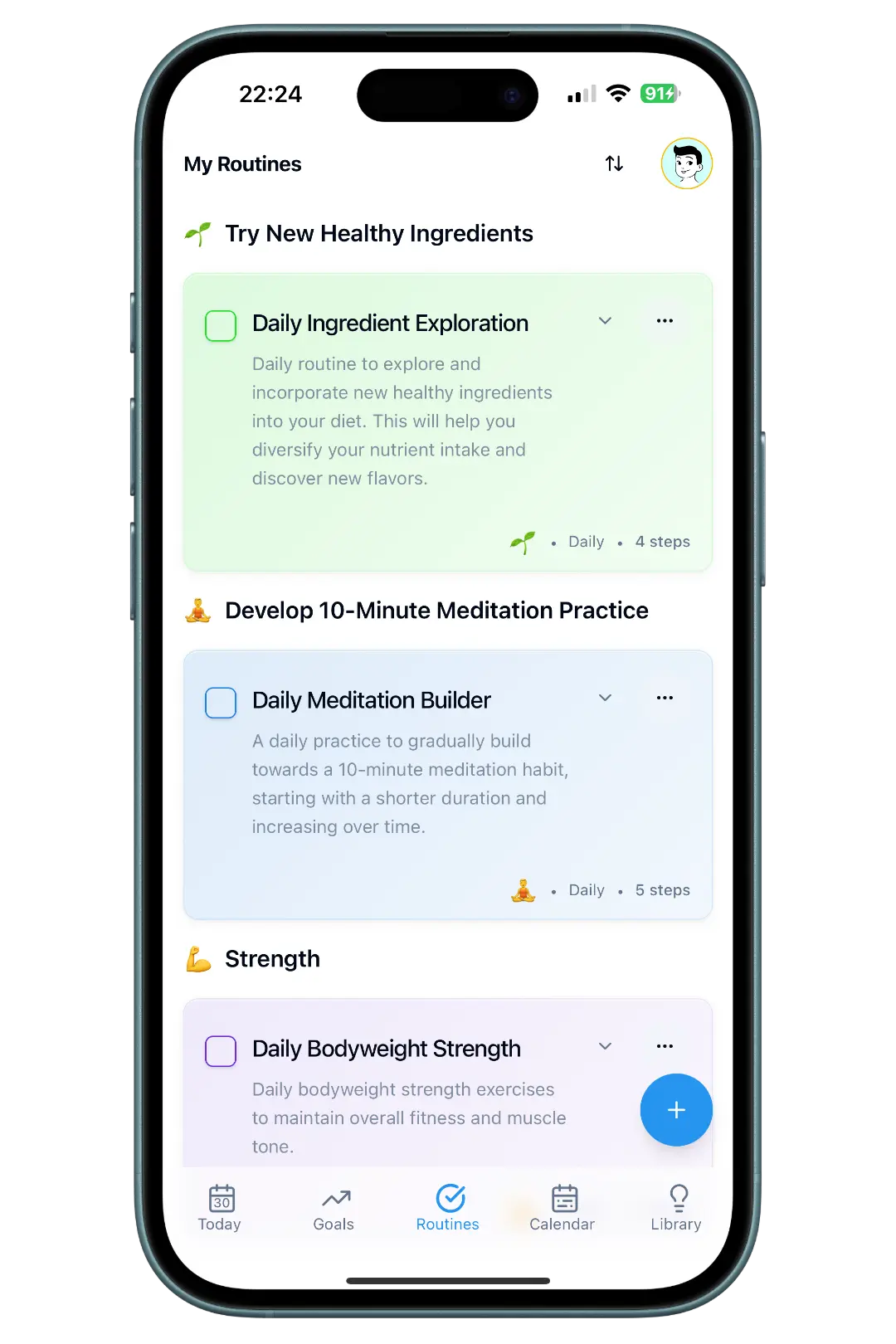
Simplify Your Wellness with a Structured Approach
February 10, 2025
In the age of infinite wellness advice, the biggest challenge isn't finding information—it's organizing it into something actionable. You're bombarded with conflicting advice: "Try this superfood!" "This workout changes everything!" "Here's the secret to perfect health!" The result? Paralysis, overwhelm, and a scattered approach that leads nowhere. Here's how to cut through the noise with a structured approach that actually works.
The Wellness Overwhelm Crisis
Why More Information Creates Less Results
Information Overload Problems:
- Decision paralysis: Too many options prevent any action
- Shiny object syndrome: Constantly switching between new approaches
- Contradiction confusion: Conflicting advice creates doubt and inaction
- Perfectionism trap: Waiting to find the "perfect" approach before starting
The Simplicity Solution: Structure eliminates overwhelm by providing clear priorities, logical sequences, and proven systems that remove guesswork from your wellness journey.
The Hidden Cost of Complexity
Complex wellness approaches cost you:
- Mental energy: Constant decision-making depletes willpower
- Time: Researching and planning instead of doing
- Confidence: Feeling confused and incompetent
- Results: Scattered efforts produce scattered outcomes
Structured approaches give you:
- Mental clarity: Clear priorities and next steps
- Time efficiency: Proven systems eliminate guesswork
- Confidence: Competence builds through systematic progress
- Consistent results: Focused efforts compound effectively
The S.I.M.P.L.E. Wellness Structure
S - Streamline Your Goals
Principle: Focus on 1-3 core wellness goals instead of trying to improve everything simultaneously.
The Goal Hierarchy Method:
- Primary goal (60% of focus): Your main health priority
- Secondary goal (30% of focus): Supports your primary goal
- Maintenance goal (10% of focus): Maintain current positive habits
Example Goal Structures:
For Weight Management:
- Primary (60%): Consistent daily movement
- Secondary (30%): Improved meal planning and nutrition
- Maintenance (10%): Continue current sleep routine
For Energy Enhancement:
- Primary (60%): Optimize sleep quality and consistency
- Secondary (30%): Stress management practices
- Maintenance (10%): Maintain current exercise routine
For Stress Reduction:
- Primary (60%): Daily mindfulness practice
- Secondary (30%): Regular physical activity
- Maintenance (10%): Continue healthy eating patterns
I - Implement Systems, Not Habits
Principle: Build interconnected systems where each element supports the others.
The Wellness Systems Approach:
System 1: Energy Management
- Sleep system: Consistent bedtime routine + environment optimization
- Nutrition system: Meal timing + hydration + balanced choices
- Recovery system: Stress management + rest periods
System 2: Movement Integration
- Daily movement: Non-negotiable minimum movement
- Structured exercise: Planned workouts that challenge you
- Active lifestyle: Integration of movement into daily activities
System 3: Progress Tracking
- Data collection: Daily metrics in ProgressMade
- Pattern recognition: Weekly trend analysis
- System optimization: Monthly adjustments based on results
M - Minimize Decision Points
Principle: Pre-decide as much as possible to preserve mental energy for execution.
Pre-Decision Strategies:
Meal Planning Pre-Decisions:
- Breakfast: Same 3 options you rotate
- Lunch: Batch-prepared options for the week
- Dinner: Planned menu with backup options
- Snacks: Pre-portioned healthy options always available
Exercise Pre-Decisions:
- When: Same time each day
- Where: Primary location + backup location
- What: Planned routine with alternatives for different scenarios
- Duration: Standard time with shorter options for busy days
Tracking Pre-Decisions:
- What to track: Core metrics only
- When to track: Immediately after completion
- How to track: ProgressMade setup for instant logging
- Review timing: Weekly pattern review, monthly system assessment
P - Prioritize Foundation First
Principle: Build your wellness on unshakeable fundamentals before adding advanced elements.
The Wellness Foundation Pyramid:
Level 1: Basic Survival Needs
- Adequate sleep (7-9 hours)
- Regular hydration (half body weight in ounces daily)
- Consistent movement (minimum 5 minutes daily)
- Stress management basics (breathing, brief relaxation)
Level 2: Optimization Habits
- Meal planning and preparation
- Structured exercise routine
- Regular sleep/wake schedule
- Tracking and measurement systems
Level 3: Enhancement Practices
- Advanced nutrition strategies
- Specialized fitness training
- Detailed biometric tracking
- Lifestyle optimization experiments
Foundation-First Rules:
- Master Level 1 completely before advancing
- Never sacrifice foundation for enhancement
- Return to foundation during stressful periods
- Build comeback protocols around foundation practices
L - Link Everything Together
Principle: Create connections between wellness elements so they reinforce each other.
Linkage Strategies:
Habit Stacking Chains:
- Morning: Water → Movement → Healthy breakfast → ProgressMade check-in
- Workday: Standing break → Hydration → Healthy snack → Energy tracking
- Evening: Workout → Nutritious dinner → Relaxation → Sleep prep
Outcome Linkages:
- Better sleep → More energy → Better food choices → Improved mood
- Regular exercise → Stress relief → Better sleep → Enhanced recovery
- Consistent nutrition → Stable energy → Better workouts → Improved body composition
Social Linkages:
- Family meals that support healthy eating
- Exercise buddies for accountability
- ProgressMade community for motivation
- Professional support when needed
E - Evolve Systematically
Principle: Continuously improve your structure based on data and experience, not random experimentation.
Systematic Evolution Process:
Weekly Micro-Adjustments:
- Analyze what worked and what didn't
- Make small timing or approach tweaks
- Test adjustments for one week
- Keep changes that improve results
Monthly System Reviews:
- Evaluate overall system effectiveness
- Identify bottlenecks or friction points
- Consider expanding successful elements
- Simplify or remove ineffective components
Quarterly Major Evolution:
- Assess progress toward main goals
- Consider adding new system elements
- Evaluate whether structure still serves your life
- Plan next quarter's focus and priorities
Implementing Your Structured Wellness Approach
Week 1: Structure Assessment
Goal: Understand your current wellness structure and identify priorities
Daily Actions:
- Audit your current wellness practices
- Identify your top 3 wellness goals using the hierarchy method
- Track current habits in ProgressMade without changing anything
- Note decision points that create stress or confusion
Week 2: Foundation Building
Goal: Establish Level 1 foundation practices
Daily Actions:
- Choose one foundational habit from each core area (sleep, movement, nutrition, stress)
- Create minimum viable versions for challenging days
- Set up environmental support for chosen habits
- Pre-decide timing and triggers for each habit
Week 3: System Integration
Goal: Link your foundation practices together
Daily Actions:
- Create habit stacking sequences
- Practice linked routines consistently
- Notice how habits influence each other
- Optimize timing based on energy and schedule
Week 4: Structure Optimization
Goal: Refine your structure based on real-world testing
Daily Actions:
- Review week's tracking data for patterns
- Identify and eliminate remaining friction points
- Adjust structure elements that aren't working
- Plan for next month's systematic evolution
Common Structuring Mistakes
Mistake 1: Over-Structuring
Problem: Creating such rigid structure that it breaks under real-life pressure Solution: Build flexibility into your structure with multiple options and adaptation protocols
Mistake 2: Under-Committing
Problem: Making structure so loose that it provides no guidance Solution: Create specific enough structure to eliminate daily decision-making
Mistake 3: Perfectionist Structure
Problem: Designing structure for ideal circumstances only Solution: Plan specifically for average and challenging days
Mistake 4: Static Structure
Problem: Never adapting structure as life and goals change Solution: Build systematic review and evolution processes
Your Structured Wellness Toolkit
Daily Structure Tools
- Morning routine checklist: 3-5 foundation habits
- Meal planning template: Pre-decided healthy options
- Movement menu: Options for different time/energy levels
- Evening wind-down sequence: Consistent relaxation routine
Weekly Structure Tools
- Weekly planning session: 15 minutes to set wellness intentions
- Progress review: Analyze ProgressMade data for patterns
- Meal prep session: Batch preparation for the week
- Structure adjustment: Small tweaks based on previous week
Monthly Structure Tools
- Goal assessment: Progress toward primary wellness goals
- System evaluation: What's working well vs. what needs improvement
- Structure evolution: Strategic changes to improve effectiveness
- Planning session: Set intentions and priorities for next month
The 90-Day Structure Implementation
Days 1-30: Foundation Structure
- Establish core systems for sleep, movement, nutrition, and stress management
- Focus on consistency over optimization
- Track daily in ProgressMade
- Build confidence in your structural approach
Days 31-60: Integration and Optimization
- Link systems together for compound benefits
- Optimize timing and remove friction
- Add secondary goal elements
- Test structure under various life circumstances
Days 61-90: Evolution and Expansion
- Systematically improve based on 60 days of data
- Consider adding Level 2 enhancement practices
- Share structure with others for accountability
- Plan next quarter's structural focus
The Structure Success Promise
A well-designed wellness structure eliminates the daily stress of figuring out what to do for your health. Instead of constantly deciding, researching, and second-guessing, you simply follow your proven system.
After 90 days of structured wellness, you'll have:
- Clear priorities that guide all health decisions
- Automatic routines that require minimal willpower
- Integrated systems that support each other
- Confidence in your ability to maintain long-term wellness
Your wellness doesn't need to be complicated to be effective. In fact, the simpler and more structured your approach, the more likely you are to maintain it long-term.
Start with the S.I.M.P.L.E. framework today. Choose your three core goals, build your foundation, and trust in the power of structured simplicity.
Your organized, sustainable wellness journey begins with one clear structure.
What will your primary wellness goal be?
